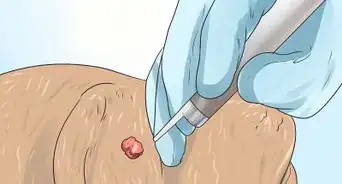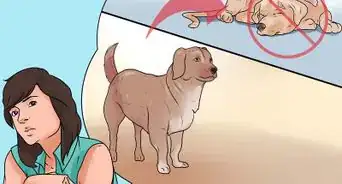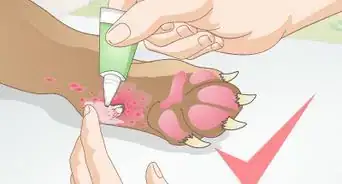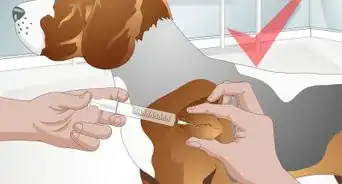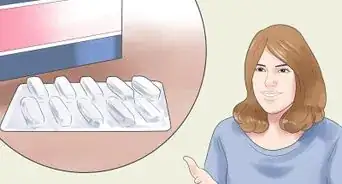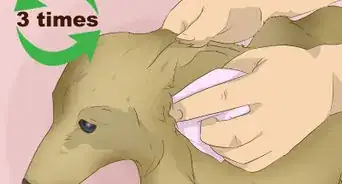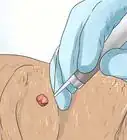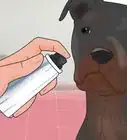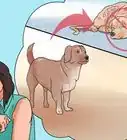This article was co-authored by Pippa Elliott, MRCVS and by wikiHow staff writer, Luke Smith, MFA. Dr. Elliott, BVMS, MRCVS is a veterinarian with over 30 years of experience in veterinary surgery and companion animal practice. She graduated from the University of Glasgow in 1987 with a degree in veterinary medicine and surgery. She has worked at the same animal clinic in her hometown for over 20 years.
There are 8 references cited in this article, which can be found at the bottom of the page.
wikiHow marks an article as reader-approved once it receives enough positive feedback. In this case, several readers have written to tell us that this article was helpful to them, earning it our reader-approved status.
This article has been viewed 699,356 times.
While a skin tag on your furry friend is more or less harmless, it can be a bit of an eyesore. What’s more, it may get caught on something and cause injury, leading to bleeding or infection. We’ll show you how to remove them at home, but if at all possible, consult a veterinarian beforehand, since most vets don’t recommend removing a dog’s skin tag yourself without proper medical training.
Things You Should Know
- Clip your dog’s fur surrounding the tag. Then, disinfect the patch of skin with 70% isopropyl alcohol.
- Cut the dog's tag with curved mayo scissors while someone else holds the dog to keep them calm and safe.
- Apply a gauze bandage to the area and wait 3-5 days for the wound to heal.
- Always consult a veterinarian before you perform any procedures on your pet.
Steps
Cleaning the Tag and Sterilizing Your Tools
-
1Confirm that the growth is a skin tag. Skin tags in dogs can be easily confused with warts, which are more dangerous because they can grow into malignant tumors. Unlike warts, though, skin tags have a narrow stalk that is attached loosely to the skin. They may be flat or teardrop-shaped, can move or dangle, and they are the same color as the dog’s skin.[1]
- Note that skin tags aren’t general harmful to your pup, so it’s best to leave it be if it’s fairly small or otherwise not bothering them.
-
2Clip away the fur around the skin tag. If there is hair around the skin tag, remove it with an electric clipper. Brush or wipe away any stray hairs that remain after clipping. This will help you ensure that the area is clean.[2]Advertisement
-
3Disinfect the area with 70% isopropyl alcohol. Soak a cotton ball with at least 5 mL (0.17 fl oz) (a spoonful) of either 70% isopropyl alcohol or 10% povidone-iodine. Then swipe the tag itself and the area around it.[3]
-
4Have someone else hold and calm the dog. You need the dog to be still so that you can cut carefully. Enlist someone that your dog trusts to help you, so that the person can effectively keep the dog calm.[4]
-
5Sterilize surgical scissors in a pan. Sterilize a pair of curved mayo scissors if you are going to cut the skin tag. Sterilize a piece of string or floss if you want to tie off the skin tag instead. Use any clean, shallow plastic pan (or even a lunch box) for this purpose. Place 250 mL (8.5 fl oz) of water in the pan, plus 10 mL (0.34 fl oz) of 10% povidone-iodine. Immerse the scissors in the pan for a full minute to sterilize them.[5]
- Using curved scissors is important, as they will help ensure that the skin tag’s stalk is cut as close to the skin as possible.
Detaching a Skin Tag
-
1Cut the stalk of the skin tag to remove it quickly. Using the curved mayo scissors cut the stalk at its base as close to the skin as you can.[6] It will bleed, so be prepared with clean gauze bandages.
-
2Apply direct pressure to the wound with a gauze bandage. Press the bandage onto the wound for a few minutes, until you are sure that bleeding has stopped.[7] As you do, offer your dog some pets or a treat to keep it calm and reward it for its patience.
- A vet may opt to cauterize the wound, which is a more reliable method. Always opt to visit your vet for the best care.
-
3Cover the area securely. Without removing the first gauze bandage, use another piece of gauze or a bandage to cover the area.[8] It will heal in 3 to 5 days, but it’s important to keep the dog from licking or playing with the wound.
-
4Tie the skin tag as an alternative to snipping it off. Using the clean string, thread, or dental floss, tie around the base of the stalk as tightly as possible and as close to the skin as you can.[9]
- Check the area daily. The tag will swell for approximately 3 days, then it will begin to shrivel, turn dark, and fall off within a week.
-
5Keep an eye on the wound. Make sure that no infection sets in. If it does, take your dog to the veterinarian to get the infection treated. Common signs of infection include swelling, redness, or any sort of discharge.[10]
-
6Use an E-collar to keep your dog from licking the wound. You may need to put a cone on your dog if it repeatedly tries to lick the wound. Cone-shaped E-collars keep your dog from biting or licking the tied tag or the wound.[11]
Expert Q&A
-
QuestionCan skin tags be a sign of cancer?
 Melissa Nelson, DVM, PhDDr. Nelson is a Veterinarian who specializes in Companion and Large Animal Medicine in Minnesota, where she has over 18 years of experience as a veterinarian in a rural clinic. She received her Doctor of Veterinary Medicine from the University of Minnesota in 1998.
Melissa Nelson, DVM, PhDDr. Nelson is a Veterinarian who specializes in Companion and Large Animal Medicine in Minnesota, where she has over 18 years of experience as a veterinarian in a rural clinic. She received her Doctor of Veterinary Medicine from the University of Minnesota in 1998.
Veterinarian Occasionally a lesion that appears to be a skin tag can actually be a cancerous lesion. Consult your vet for advice.
Occasionally a lesion that appears to be a skin tag can actually be a cancerous lesion. Consult your vet for advice. -
QuestionIs it safe to remove a skin tag from below a dog's eye at home?
 Melissa Nelson, DVM, PhDDr. Nelson is a Veterinarian who specializes in Companion and Large Animal Medicine in Minnesota, where she has over 18 years of experience as a veterinarian in a rural clinic. She received her Doctor of Veterinary Medicine from the University of Minnesota in 1998.
Melissa Nelson, DVM, PhDDr. Nelson is a Veterinarian who specializes in Companion and Large Animal Medicine in Minnesota, where she has over 18 years of experience as a veterinarian in a rural clinic. She received her Doctor of Veterinary Medicine from the University of Minnesota in 1998.
Veterinarian No. The eye is a very delicate area, and trying to remove a skin tag can cause corneal abrasions that can lead to blindness and permanent damage. Take your pet to the vet.
No. The eye is a very delicate area, and trying to remove a skin tag can cause corneal abrasions that can lead to blindness and permanent damage. Take your pet to the vet. -
QuestionCan skin tags be a sign of cancer?
 Pippa Elliott, MRCVSDr. Elliott, BVMS, MRCVS is a veterinarian with over 30 years of experience in veterinary surgery and companion animal practice. She graduated from the University of Glasgow in 1987 with a degree in veterinary medicine and surgery. She has worked at the same animal clinic in her hometown for over 20 years.
Pippa Elliott, MRCVSDr. Elliott, BVMS, MRCVS is a veterinarian with over 30 years of experience in veterinary surgery and companion animal practice. She graduated from the University of Glasgow in 1987 with a degree in veterinary medicine and surgery. She has worked at the same animal clinic in her hometown for over 20 years.
Veterinarian A true skin tag is just that, a small extra piece of skin. They are not usually a sign of cancer; however, anything unusual, swollen, or that is growing quickly must always be checked by a vet.
A true skin tag is just that, a small extra piece of skin. They are not usually a sign of cancer; however, anything unusual, swollen, or that is growing quickly must always be checked by a vet.
References
- ↑ https://www.mspca.org/angell_services/benign-skin-masses-of-dogs/
- ↑ https://www.nyu.edu/research/resources-and-support-offices/getting-started-withyourresearch/research-with-animals/office-of-veterinary-resources/training/animal-preparation.html
- ↑ https://www.research.psu.edu/animalresourceprogram/surgery/animal-preparation
- ↑ https://www.ccspca.com/blog-spca/education/anxious-dog/
- ↑ https://microbiologyjournal.org/sterilization-of-surgical-tools-removing-bacterial-endospores-with-a-combination-of-povidone-iodine-chlorhexidine-gluconate-ethanol-and-methanol/
- ↑ https://healthcare.utah.edu/healthfeed/postings/2018/04/skin-tags.php
- ↑ https://www.facs.org/media/zr5dimjk/wound_surgical.pdf
- ↑ https://www.facs.org/media/zr5dimjk/wound_surgical.pdf
- ↑ https://healthcare.utah.edu/healthfeed/postings/2018/04/skin-tags.php
About This Article
While it's best to have a vet remove your dog's skin tags since there's a slight risk of complications, you can attempt to do it at home yourself. Start by trimming any hair surrounding it and wiping the area with an isopropyl alcohol-soaked cotton ball to disinfect it. Once you’ve trimmed and cleaned the skin around your dog’s skin tag, cut the stalk of the skin tag as close to the skin as you can with sterilized scissors. Be ready with clean gauze bandages, since it will probably bleed. Alternatively, tie string, thread, or dental floss around the base of the stalk as tightly as you can, which will cut off the blood supply and cause it to fall off within a week. Whichever way you remove the skin tag, cover the area with gauze or a bandage to prevent your dog licking or playing with the wound until it heals. For more tips from our Veterinary co-author, including how to identify a skin tag, read on!











